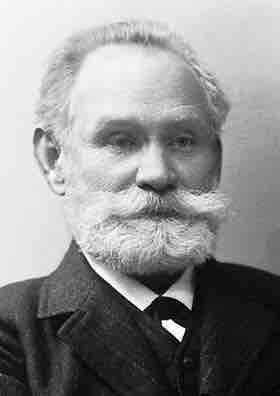Ivan Pavlov (1849–1936) was a Russian scientist whose work with dogs has been influential in understanding how learning occurs. Through his research, he established the theory of classical conditioning.

Ivan Pavlov
Pavlov is known for his studies in classical conditioning, which have been influential in understanding learning.
Basic Principles of Classical Conditioning
Classical conditioning is a form of learning whereby a conditioned stimulus (CS) becomes associated with an unrelated unconditioned stimulus (US) in order to produce a behavioral response known as a conditioned response (CR). The conditioned response is the learned response to the previously neutral stimulus. The unconditioned stimulus is usually a biologically significant stimulus such as food or pain that elicits an unconditioned response (UR) from the start. The conditioned stimulus is usually neutral and produces no particular response at first, but after conditioning it elicits the conditioned response.
Extinction is the decrease in the conditioned response when the unconditioned stimulus is no longer presented with the conditioned stimulus. When presented with the conditioned stimulus alone, the individual would show a weaker and weaker response, and finally no response. In classical-conditioning terms, there is a gradual weakening and disappearance of the conditioned response. Related to this, spontaneous recovery refers to the return of a previously extinguished conditioned response following a rest period. Research has found that with repeated extinction/recovery cycles, the conditioned response tends to be less intense with each period of recovery.
Pavlov's Famous Study
The best-known of Pavlov's experiments involves the study of the salivation of dogs. Pavlov was originally studying the saliva of dogs as it related to digestion, but as he conducted his research, he noticed that the dogs would begin to salivate every time he entered the room—even if he had no food. The dogs were associating his entrance into the room with being fed. This led Pavlov to design a series of experiments in which he used various sound objects, such as a buzzer, to condition the salivation response in dogs.
He started by sounding a buzzer each time food was given to the dogs and found that the dogs would start salivating immediately after hearing the buzzer—even before seeing the food. After a period of time, Pavlov began sounding the buzzer without giving any food at all and found that the dogs continued to salivate at the sound of the buzzer even in the absence of food. They had learned to associate the sound of the buzzer with being fed.
If we look at Pavlov's experiment, we can identify the four factors of classical conditioning at work:
- The unconditioned response was the dogs' natural salivation in response to seeing or smelling their food.
- The unconditioned stimulus was the sight or smell of the food itself.
- The conditioned stimulus was the ringing of the bell, which previously had no association with food.
- The conditioned response, therefore, was the salivation of the dogs in response to the ringing of the bell, even when no food was present.
Pavlov had successfully associated an unconditioned response (natural salivation in response to food) with a conditioned stimulus (a buzzer), eventually creating a conditioned response (salivation in response to a buzzer). With these results, Pavlov established his theory of classical conditioning.
Classical conditioning
Before conditioning, an unconditioned stimulus (food) produces an unconditioned response (salivation), and a neutral stimulus (bell) does not have an effect. During conditioning, the unconditioned stimulus (food) is presented repeatedly just after the presentation of the neutral stimulus (bell). After conditioning, the neutral stimulus alone produces a conditioned response (salivation), thus becoming a conditioned stimulus.
Neurological Response to Conditioning
Consider how the conditioned response occurs in the brain. When a dog sees food, the visual and olfactory stimuli send information to the brain through their respective neural pathways, ultimately activating the salivation glands to secrete saliva. This reaction is a natural biological process as saliva aids in the digestion of food. When a dog hears a buzzer and at the same time sees food, the auditory stimulus activates the associated neural pathways. However, because these pathways are being activated at the same time as the other neural pathways, there are weak synapse reactions that occur between the auditory stimulus and the behavioral response. Over time, these synapses are strengthened so that it only takes the sound of a buzzer (or a bell) to activate the pathway leading to salivation.
Behaviorism and Other Research
Pavlov's research contributed to other studies and theories in behaviorism, which is an approach to psychology interested in observable behaviors rather than the inner workings of the mind. The philosopher Bertrand Russell argued that Pavlov's work was an important contribution to a philosophy of mind. Pavlov's research also contributed to Hans Eysench's personality theory of introversion and extroversion. Eysench built upon Pavlov's research on dogs, hypothesizing that the differences in arousal that the dogs displayed was due to inborn genetic differences. Eysench then extended the research to human personality traits.
Pavlov's research further led to the development of important behavior-therapy techniques, such as flooding and desensitizing, for individuals who struggle with fear and anxiety. Desensitizing is a kind of reverse conditioning in which an individual is repeatedly exposed to the thing that is causing the anxiety. Flooding is similar in that it exposes an individual to the thing causing the anxiety, but it does so in a more intense and prolonged way.